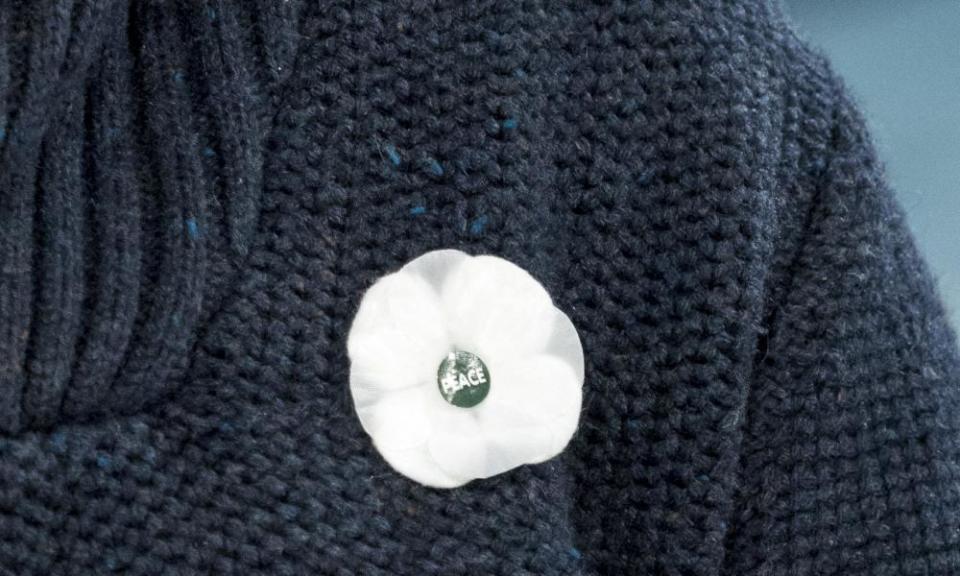St John Ambulance to let volunteers wear white remembrance poppy

St John Ambulance is allowing its volunteers to wear the pacifist white poppy for the first time.
The 141-year-old first-aid organisation’s dress code change, a month before the centenary of the first world war armistice, was welcomed by the Peace Pledge Union (PPU), which distributes the alternative to the Royal British Legion’s red poppy.
The history of St John Ambulance is tightly bound up with the Battle of the Somme, the horrors of which inspired the red poppy tradition. Its volunteers died trying to save lives in the trenches.
The PPU is hoping more than 100,000 white poppies will be sold from Monday. It believes the red poppy symbolises remembrance of British armed forces and its allies, rather than enemies and civilians who also died in wars.
At least 30 schools have said they will offer white poppies despite previous accusations by Col Richard Kemp, an Afghanistan veteran, that the union was “indoctrinating children with a leftwing political agenda”.
The spread of the pacifist symbol is facing resistance elsewhere, as the annual culture war over the meaning of the poppy begins again.
Jeremy Corbyn, who has worn both red and white poppies, said he would not wear the white poppy for the armistice centenary. “As in previous years, Jeremy will be wearing a red poppy in remembrance of those who have died in war,” a spokesman for the Labour leader said.
A church in Malpas, Cheshire, has dismissed attempts by peace activists to install a banner decorated with white poppies as part of its commemorations.
An armistice banner featuring a rising sun, a dove and white poppies made by women including Joan Meredith, an 88-year old veteran peace campaigner, was rejected by St Oswald’s.
She said: “White poppies are to remember all victims of war, to challenge militarism and build a culture of peace. I am more than disappointed with the rector.”
The church’s rector, Ian Davenport, said the red poppy was the traditional symbol of remembrance and he did not “want to alter that message, especially in this centenary year of remembrance”.
Simone Ramacci, a St John volunteer, said he could not “in good conscience wear the red poppy that has fallen from representing remembrance of countless war deaths to being a symbol of lip service to ‘our troops’”.
The white poppy movement has repeatedly been rebuffed by charities and high-street retailers, which decline to stock them. The actor Mark Rylance and the Green party peer Jenny Jones are among its supporters.
The Royal British Legion’s poppy appeal distributed 45m poppies last year, and expects to generate at least £50m this year.
The PPU says the white poppy remembers all victims of war and is “a commitment to peace and a challenge to attempts to glamorise or celebrate war”. But its critics claim it is wrong to remember enemies if they include aggressors such as Nazi soldiers.
Pacifists object to the Royal British Legion’s close association with the British military and veterans. The veteran journalist Robert Fisk has claimed red poppies have “become a symbol of racism” because they symbolise the remembrance of UK and allied dead, not, for example, Iraqis killed in the 2003 invasion.
The legion spends much of its money on British military veterans and their families, and on campaigning for the armed forces. But suggestions that the red poppy is militaristic have been rejected by John Nichol, an RAF Tornado navigator who was shot down over Iraq, captured and tortured by Saddam Hussein’s forces during the Gulf war in 1991.
“It’s our remembrance and we shouldn’t beat ourselves up about that,” he said. “It disappoints me that the people who do the white poppy always piggyback on the red poppy. Why don’t they do it in July.”
Catherine Davies, the head of remembrance at Royal British Legion, said the organisation saw no contradiction in wearing other symbols alongside the red poppy. “The red poppy is a symbol of remembrance and hope for a peaceful future, it is inclusive of all who wish to wear it, is non-political and does not depict support for war,” she said.
In 2016, Fifa tried to prevent the England football team from displaying the poppy on their shirts, saying it was a “political symbol”, which Theresa May described as “utterly outrageous”.
A spokesman for the PPU welcomed St John’s decision and said: “It is not appropriate for the British legion to continue to claim to be ‘custodians of remembrance’ when they represent only one particular approach to it.”
The red poppy was first made and sold by an American academic, Moina Michael. She had been inspired by the poem In Flanders Fields by the Canadian soldier John McCrae.
Michael’s poppies were brought to England by Anna Guérin, and the Royal British Legion took them up as a fundraising device in 1921. The white poppy followed in 1933 when members of the Co-operative Women’s Guild began wearing it as an anti-war symbol.

 Yahoo News
Yahoo News 